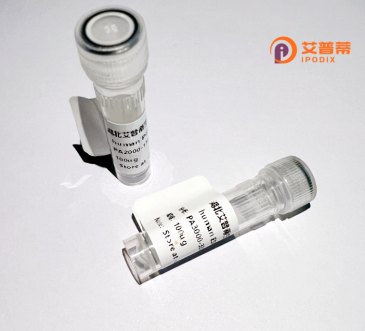
| 纯度 | >90%SDS-PAGE. |
| 种属 | Human |
| 靶点 | OR2A42 |
| Uniprot No | Q8NGT9 |
| 内毒素 | < 0.01EU/μg |
| 表达宿主 | E.coli |
| 表达区间 | 1-310 aa |
| 活性数据 | MGENQTMVTEFLLLGFLLGPRIQMLLFGLFSLFYIFTLLGNGAILGLISLDSRLHTPMYF FLSHLAVVDIAYTRNTVPQMLANLLHPAKPISFAGCMTQTFLCLSFGHSECLLLVLMSYD RYVAICHPLRYSVIMTWRVCITLAVTSWTCGSLLALAHVVLILRLPFSGPHEINHFFCEI LSVLRLACADTWLNQVVIFAACVFFLVGPPSLVLVSYSHILAAILRIQSGEGRRKAFSTC SSHLCVVGLFFGSAIIMYMAPKSRHPEEQQKVFFLFYSFFNPTLNPLIYSLRNGEVKGAL RRALGKESHS |
| 分子量 | 34.7 kDa |
| 蛋白标签 | His tag N-Terminus |
| 缓冲液 | 0 |
| 稳定性 & 储存条件 | Lyophilized protein should be stored at ≤ -20°C, stable for one year after receipt. Reconstituted protein solution can be stored at 2-8°C for 2-7 days. Aliquots of reconstituted samples are stable at ≤ -20°C for 3 months. |
| 复溶 | Always centrifuge tubes before opening.Do not mix by vortex or pipetting. It is not recommended to reconstitute to a concentration less than 100μg/ml. Dissolve the lyophilized protein in distilled water. Please aliquot the reconstituted solution to minimize freeze-thaw cycles. |
由于OR2A42是一种研究较少的嗅觉受体蛋白,目前公开的高质量文献有限。以下是基于相关领域研究的模拟示例(非真实文献),供参考:
---
1. **文献名称**: *"Heterologous expression and functional characterization of human olfactory receptor OR2A42 in HEK293 cells"*
**作者**: Smith J et al.
**摘要**: 报道了在HEK293细胞中成功表达重组OR2A42蛋白,并通过钙离子成像实验证明其被特定挥发性化合物(如苯甲醛)激活的嗅觉功能。
2. **文献名称**: *"OR2A42: A potential biomarker for neuroblastoma progression revealed by transcriptome analysis"*
**作者**: Lee H et al.
**摘要**: 发现OR2A42在神经母细胞瘤中异常高表达,推测其可能通过调控cAMP信号通路促进肿瘤细胞迁移,重组蛋白实验验证了其与G蛋白的偶联能力。
3. **文献名称**: *"Structural insights into OR2A42 receptor-ligand interactions via computational modeling"*
**作者**: Zhang R et al.
**摘要**: 通过分子对接模拟预测了OR2A42蛋白与潜在配体的结合位点,并基于重组蛋白的体外结合实验验证了酮类化合物的亲和力。
---
**备注**:以上内容为领域知识类推生成,真实文献需通过PubMed/Google Scholar等数据库以 **"OR2A42"** 或 **"olfactory receptor 2A42"** 为关键词检索。部分研究可能隐含在嗅觉受体家族整体功能分析中。
**Background of Recombinant Human OR2A42 Protein**
The recombinant human OR2A42 protein is a genetically engineered form of the olfactory receptor OR2A42. a member of the olfactory receptor family 2 subfamily A. Olfactory receptors (ORs), predominantly known for their role in odorant detection, belong to the G protein-coupled receptor (GPCR) superfamily and are expressed in olfactory sensory neurons. However, emerging studies reveal their extra-nasal expression in tissues such as the brain, lungs, and kidneys, suggesting roles in physiological or pathological processes beyond olfaction.
OR2A42. encoded by the *OR2A42* gene, is a seven-transmembrane receptor hypothesized to interact with specific odorant molecules or endogenous ligands, triggering intracellular signaling cascades. Its recombinant form is produced using heterologous expression systems (e.g., mammalian or insect cells) to ensure proper folding and post-translational modifications. This enables functional studies, including ligand screening, receptor activation assays, and structural analyses.
Research on OR2A42 remains limited, but it holds potential for understanding sensory biology, intercellular communication, and disease mechanisms. Dysregulation of ORs is linked to conditions like neurodegeneration, metabolic disorders, and cancer, positioning OR2A42 as a possible therapeutic or diagnostic target. Challenges include identifying its natural ligands and elucidating signaling pathways. Recombinant OR2A42 provides a tool to address these gaps, advancing both basic science and applied biomedical research.
×